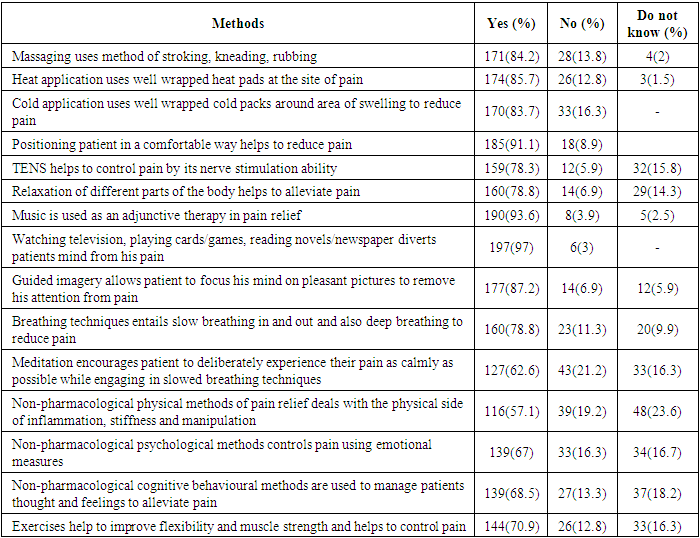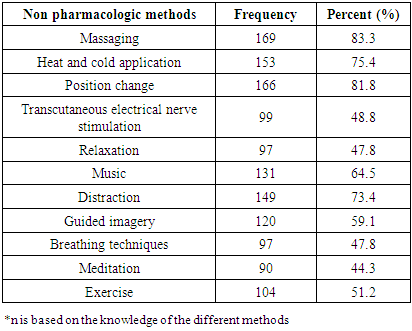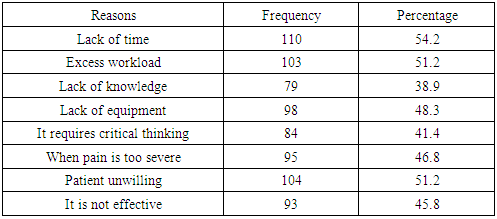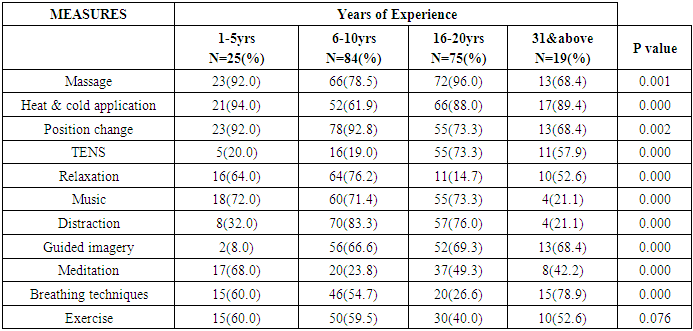Ada Nwaneri, Ifeoma Ndubuisi, Agnes Anarodo, Ijeoma Okoronkwo, Esther Offor
Department of Nursing Sciences, University of Nigeria, Enugu Campus, Nigeria
Correspondence to: Ifeoma Ndubuisi, Department of Nursing Sciences, University of Nigeria, Enugu Campus, Nigeria.
| Email: |  |
Copyright © 2018 The Author(s). Published by Scientific & Academic Publishing.
This work is licensed under the Creative Commons Attribution International License (CC BY).
http://creativecommons.org/licenses/by/4.0/

Abstract
Background: The pathophysiology of pain is complex and therefore multi-dimensional based treatment approach, including non-pharmacological pain relief therapy should be used to enhance pain management. Aim: The study assessed nurses’ level of knowledge and utilisation of non-pharmacological pain control for orthopaedic patients in Enugu. Method: This descriptive study was conducted at two federal tertiary health institutions in Enugu using two hundred and three (203) randomly selected consenting nurses working full time in both hospitals. Data were collected using researcher constructed and pre-tested questionnaire. Analysis used proportions and Chi-square to test for associations between variables at five percent level of significance. Result: The result showed that nurses were more aware of the physical methods (85.7%) of non-pharmacological pain control when compared to cognitive (68.5%) and psychological (49.8%) methods. Massaging (85.7%) and change of patients’ position (83.3%), were the physical methods often used by these nurses. Lack of time (54.2%), excessive workload (51.2%), and lack of knowledge of some of the various alternative measures (38.9%) were their proffered reasons for not practicing alternative methods of pain control. There was no significant (p>0.05) relationship between level of professional qualification and nurses’ attitude to the use of the alternative methods of pain control while there was a relationship (p<0.05) between number of years of practice and the use of alternative methods of pain control.Conclusion: Nurses have adequate knowledge of the non-pharmacological methods of pain control. However, the utilisations of cognitive and psychological methods were minimal. There is need therefore, to educate nurses on these other methods, in order to afford patients a variety of pain relief methods to choose from and augment the pharmacological agents used.
Keywords:
Orthopaedic pain, Non-pharmacological pain relief, Nurses
Cite this paper: Ada Nwaneri, Ifeoma Ndubuisi, Agnes Anarodo, Ijeoma Okoronkwo, Esther Offor, Nurses’ Knowledge and Level of Utilisation of Non-Pharmacological Pain Control for Orthopaedic Patients in Enugu Nigeria, International Journal of Nursing Science, Vol. 8 No. 4, 2018, pp. 61-66. doi: 10.5923/j.nursing.20180804.01.
1. Introduction
Pain is a universal human experience which is as old as the universe itself and the most common reason people seek medical care. World Health Organisation (WHO), 2018 stated that the greatest proportion of persistent pain conditions is accounted for by musculoskeletal conditions. Musculoskeletal conditions are the second largest contributor to disability worldwide, with low back pain being the single leading cause of disability globally [1]. Many orthopaedic patients are admitted with injuries that need long term management and are prone to developing neuropathic chronic pain. The presence of pain is an indicator that there may be structural or functional disorder of the body. Unfortunately, pain cannot be objectively measured in the same way as blood pressure, pulse rate and temperature, thereby making pain a subjective individual phenomenon which only the person experiencing it could tell its severity [2]. Hence, patients’ self- reporting (expression) of their pain is regarded as the gold standard of pain assessment measurement as it provides the most valid measurement of pain [3]. Patients can experience severe or the worst type of pain, which is a major cause of psychological and physical disability that can lead to several complications, such as inability to perform simple activities of daily living (ADLs), loss of a job, fatigue, weight loss, hopelessness, and social isolation [4].Yet, pain is often under treated and patients continue to suffer from the ill effects of pain and lack of proper pain management [5]. A significant cause of poor management is the tendency to overlook patient report of pain, the complex and multi-dimensional approach to pain management. Consequently, pain is mostly managed with pharmacological agents. Unfortunately, over dependence on pharmacological agents exposes the patients to the risk of drug side effects [6], which could be immediate or long term, and may not satisfactorily control the psychological aspect of pain. Nature of pain being complex, therefore, medications alone may be insufficient for relief and multiple strategies must be utilised [7]. Although there is an increase of knowledge and developments in technological resources regarding pain, many patients still experience pain [8]. Alternative pain relief measures have been advocated by many health professionals to augment the effects of drugs and to reduce the various degrees of side effects caused by the use of medications in pain management in orthopaedic patients [6]. A nurse’s accurate assessment, prompt pharmacological or non-pharmacological intervention, and evaluation of pain relief administered are necessary for positive outcomes in patients and the maintenance of health [9]. The non-pharmacological strategies include stimulation methods (e.g. massage, heat or cold packs, transcutaneous nerve stimulation), cognitive-behavioural methods (e.g. meditation, relaxation techniques, hypnotherapy, music therapy, bio-feedback) and other methods (e.g. acupuncture, acupressure) [10].Many of these alternative approaches are non-invasive, low risk, inexpensive, and easily performed at the clinical settings [11]. They achieve their effects in numerous ways, not only in reducing the pain but also by managing the emotional components, thus reducing anxiety, facilitating coping skills, providing a sense of control, enhancing comfort, promoting sleep, reducing fatigue and improving quality of life [12]. The goal is to increase the individual’s experience of well-being [13].Nurses are the closest health personnel to the patients and as such are in very good position to provide non pharmacological pain control, but unfortunately, studies in other parts of the world report that nurses have poor knowledge in the application of these alternative pain relief measures [14]. No study however, has been conducted in this part of the country to refute or confirm this claim. The question therefore is do nurses’ in teaching hospitals in Enugu have adequate knowledge about alternative methods of pain relief and if they utilise it, to what extent do they use them. The aim of the study is to assess the level of utilisation of non-pharmacological pain control for orthopaedic patients in Enugu.
2. Methodology
It is a descriptive questionnaire based study done at two federal tertiary hospitals in Enugu state. Two hundred and three (203) consenting qualified nurses with a minimum of two years’ experience post qualification were recruited and administered a researcher developed and pre-tested questionnaire. Ethical clearance was gotten from research and ethics committee of National Orthopaedic Hospital, Enugu. Administrative permit was gottrn from the heads of units of the two sites and informed consent was obtained from the respondents before the distribution of the questionnaires. All the consenting registered nurses working in the two sites were used for the study. A pre-tested researcher developed questionnaire with face and content validity was the instrument of data collection. The questionnaire contained 29 items- close and open ended questions generated to cover the objectives. Two hundred and three (203) properly filled questionnaires were returned and these were coded and analysed using proportions whereas variable associations were tested using Chi-square at five percent alpha level of significance.
3. Results
A total of 203 nurses completed the questionnaires. Seventy-one (35%) of them were between the ages of 30 and 34 with a mean age of 33.83 years. Qualification was not evenly distributed, with 133(65.5%) of the nurses being orthopaedic nurses, 39(19.2%) with only RN, RM, 18(8.9%) are BSC holders and 13(6.4%) are Masters’ degree holders (Table 1). Nurses have adequate knowledge of some of the different methods of alternative pain relief and their benefits (79.8%) (Table 2). Result also showed that nurses are more aware of the physical methods (85.7%) of non-pharmacological pain control when compared to cognitive methods (68.5%) and psychological (49.8%) methods (Table 3). In the physical method, massaging (86.7%), change of patient position (83.7%), were most often used by these nurses while TENS (35%) was the least used method (Table 4). Distraction (72.4%) was the most often used cognitive method while music (79.8%) was the most often used in psychological method (Table 4). Lack of time (54.2%), excessive workload (51.2%), lack of equipment (48.3%) and lack of knowledge of some of the various alternative measures (38.9%) were some of the reasons for not practicing alternative methods of pain control (Table 5). There was good knowledge and use of the physical methods across all educational qualifications when compared with psychological and cognitive methods (p>0.05) (Table 6). Table 7 showed that those who qualified earlier use these non-pharmacological pain relief methods more (p<0.05) when compared with the fresh graduates.Table 1. Socio demographic profile of respondents
 |
| |
|
Table 2. Knowledge of the various uses of non-pharmacologic methods of pain relief
 |
| |
|
Table 3. Awareness of non-pharmacological methods of pain relief
 |
| |
|
Table 4. The methods the nurses have enough confidence and knowledge to implement
 |
| |
|
Table 5. Reasons for not constantly using these non-pharmacological methods of pain management in orthopaedic patients
 |
| |
|
Table 6. Cross tabulation between educational level and use of alternative pain relief measures
 |
| |
|
Table 7. Cross tabulation between number of years of practice and use of alternative pain relief
 |
| |
|
4. Discussion
The results of this study revealed that there is adequate knowledge of alternative pain relief measures and their benefits among nurses in orthopaedic settings. The findings also indicated that nurses believe they have enough confidence and knowledge to utilise these non-pharmacological methods. This assertion of their confidence and knowledge must have impacted on their ability to teach patients the use of most of the non-pharmacological pain relief methods, as the result in table 4 shows. It is quite understandable that the nurses have adequate knowledge of these non-pharmacological methods and expressed the confidence to utilise them since majority of them have orthopaedic training and most of them acquired the knowledge through their course of education. What was surprising, however, is that simple techniques such as guided imagery, meditation and breathing techniques were neither amongst the techniques majority of the nurses claimed to have enough confidence and knowledge to implement nor among those patients were taught. This implies that more teaching and guidance is needed to update and direct these nurses. The findings of this study is however not in line to the findings by King, Pettigrew and Reed [15] that nurses do not have knowledge about these alternative therapies and the findings by Brolinson, Price, Ditmyer and Reis [14] that a greater percentage of nurses do not know the benefits of these alternative measures.Further findings of the study revealed that of all the physical non-pharmacological methods of pain relief studied, a greater percentage of nurses use massage and position change more often, while a few use TENS as an alternative pain relief measure. This may be due to the fact that there is unavailability of the TENS machine in the ward and the expressed lack of knowledge and confidence on how to use this technique on the part of the nurses as revealed by the respondents. Contrary to the findings of this study Yilmaz et al. [15] reported that only 35.7% of the 358 nursing students surveyed in Turkey used massage to relieve pain.Nurses use psychological methods of pain relief like music to distract patients attention from pain for which majority 137(67.5%) of them use. Majority of them in addition agreed that they allowed their patients to select their choice of music which could serve as adjunctive therapy for pain relief thus reducing the amount of pain medications needed. The high importance attached to music may be because of the availability of mobile musical devices like MP3 and mobile phones that can play the patients choice of music. However, Yilmaz et al. found that only 22.6% of their study population used music therapy to relieve pain [15].Majority of the respondents use distraction as measure of pain relief and they preferred to divert patients’ attention with the use of music, while others preferred the use of books/magazine, talking to a friend, playing games, watching television as a measure to relieve their patients’ pain. Titler and Rakel, 2004 [16] asserted that these cognitive strategies alter the subjective feelings of pain intensity and preoccupy the mind with pleasant thought. The study revealed that there is statistically significant difference educational level and nurses’ use of alternative pain relief measures. However, since nurses require and obtain sound education at various levels to administer quality care to patients, their use of the alternative pain relief on these patients largely depends on the level of education they have obtained, since some of the measures require the nurse to develop critical thinking and sound knowledge to administer them effectively to relieve patients’ pain. There is a significant relationship between the nurses’ years of practice and their use of these alternative pain relief measures: massage, heat and cold application, position change, TENS, relaxation, music, distraction, guided imagery, breathing techniques, meditation. This shows that nurses’ use of these pain relief measures listed above depends to a large extent on their number of years of practise which means that the higher the number of years of experience, the greater the use of these alternative pain relief. It means that the number of years of experience determines the use of these measures, as the nurse must have acquired adequate knowledge, skills, experience and competence to manage patients’ pain effectively using alternative pain relief measures alone or in conjunction with drugs to relieve orthopaedic patients’ pain.
5. Conclusions
There is adequate Knowledge of alternative pain reliefs measures used in the management of orthopaedic patients in NOHE and UNTH. More often, physical method of non- pharmacological pain control is utilised by the nurses when compared to the other methods. This does not seem to be influenced by level of experience and qualification. It therefore appears that special attention be paid to pain management in the nursing curriculum.Distraction techniques are the cognitive behavioural non pharmacological method of pain relief often used by nurses on orthopaedic patients.In addition, there is significant difference in the educational level of nurses and their use of alternative pain relief measures.Finally, there is significant difference in the nurses’ years of practice and their use of alternative pain relief measures.
References
| [1] | WHO (2018). WHO fact sheet on musculo-skeletal conditions. Available at http://www.who.int/mediacentre/factsheets/musculoskeletal/en/. |
| [2] | McCaffery & Pasero, 2005 Pasero C, Paice JA, and McCaffery M. (1999). Basic mechanisms underlying the causes and effects of pain. In: McCaffery M, Pasero C, editors. Pain: clinical manual. St. Louis, MO: Mosby; 1999. pp. 15–34. |
| [3] | Arnstein, P. (2010). Clinical coach for effective pain management. Philadelphia, FA Davis company. Pp 74-6. |
| [4] | Wentz J. (2009) Pain management. In: Potter PA & Perry AG (Editors) Fundamental of Nursing. (7th. ed.) Mosby Elseiver, St. Louis, 1051-1085. |
| [5] | Yates P, Dewar A, Edwards H, Fentiman B, Najman J, Nash R, Richardson V, Fraser J. (1998). The prevalence and perception of pain amongst hospital in-patients. Journal of Clinical Nursing, 7,521-30. |
| [6] | Helmrich S, Yates P, Nash R, Hobman A, Poulton V, Berggren L. (2001). Factors influencing nurses' decisions to use non-pharmacological therapies to manage patients' pain. Australian Journal of Advanced Nursing, 19(1), 27-35. |
| [7] | Nadler S, Weingand K, Kruse R. (2004). The Physiologic basis and clinical application of cryotherapy and thermotherapy for the pain practitioner. Pain physician 7: 395-9. |
| [8] | Nash R, Yates P, Edwards H, Fentiman B, Dewar A, Mcdowell J, Clark R. (1999). Pain and administration of analgesia: What nurses say. Journal of clinical Nursing. 8(2): 180. |
| [9] | Plaisance L, Logan C. Nursing students’ knowledge and attitudes regarding pain. Pain Management Nursing 2006; 7(4): 167–75. |
| [10] | Adams DP, Melissa L, Gary J, Arminio DP. Nonpharmacologic pain management intervention. Clin Podiatr Med Surg 2008; 25: 409–29. |
| [11] | Allred KD, Byers JF, Sole ML. The effect of music on postoperative pain and anxiety. Pain Management Nursing 2010; 11: 15–25. Pasero C, McCaffery, M. (2011). Pain assessment and pharmacologic management. St. Louis, MO: Mosby Elsevier. Evidence Level VI. |
| [12] | Brolinson, P., Price, J., Ditmyer, M., & Reis, D. (2001). Nurses' perceptions of complementary and alternative medical therapies. Journal of Community Health, 26(3), 175-189. |
| [13] | Engwall M, Duppils GS. Music as a nursing intervention for postoperative pain: A systematic review. Journal of Perianesthesia Nursing 2009; 24(6): 370–83. |
| [14] | King M, Pettigrew A, Reed, F. (2000). Complementary, alternative, integrative: Have nurses kept pace with their clients? Urologic Nursing, 20, 323-330. |
| [15] | Yılmaz E, Yılmaz E, Karaca F, Uçar S, Yüce T. The examination of drug use by health high school students. Fırat Saglık Hizmetleri Dergisi 2008; 3(8): 69–83 [in Turkish]. KONTAKT 1 (2016) 23–31 30. |
| [16] | Titler M. Rakel B.. (2004). Nonpharmacologic treatment of pain. Critical Care Nursing Clinics of North America, 13, 221-9. |



 Abstract
Abstract Reference
Reference Full-Text PDF
Full-Text PDF Full-text HTML
Full-text HTML





